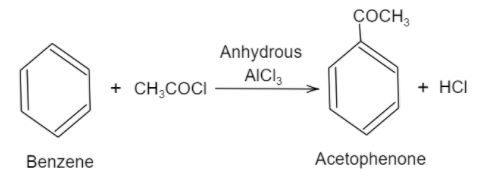
How will you convert Benzene to acetophenone?
Answer
408.9k+ views
Hint: Acetophenone is a carbonyl compound in which the ketone group is attached to the benzene ring. The catalyst used in the production of acetophenone is anhydrous aluminium chloride. The reaction is a type of electrophilic substitution reaction.
Complete answer:
Benzene (having chemical formula ${{C}_{6}}{{H}_{6}}$) can be converted to acetophenone (has chemical formula ${{C}_{6}}{{H}_{5}}COC{{H}_{3}}$), which is a methylphenyl ketone by Friedel-Crafts acylation reaction.
There are two primary types of Friedel-Crafts reaction, which are alkylation and acylation reactions. Friedel-Crafts acylation is one of the most convenient and widely used methods for the preparation of aromatic ketone, in which the ketonic group is directly attached to at least one aromatic ring. The reaction involves the treatment of an aromatic hydrocarbon with an acid halide in the presence of a Lewis acid such as aluminium chloride.
Here, when benzene is reacted with an acyl halide in the presence of anhydrous aluminium chloride, it will give an acyl benzene as a product. This reaction is a type of electrophilic substitution reaction. Firstly, ethanoyl chloride reacts with aluminium chloride and produces an electrophile. Then this electrophile reacts with benzene which will actually undergo the electrophilic substitution reaction to form acetophenone. Following is the reaction shown for the production of acetophenone:

Hence, from the above discussion, it can be seen that benzene is converted into acetophenone by Friedel-Craft acylation reaction.
Note: Possibly you may get confused with Friedel-Craft alkylation but Friedel-Craft alkylation reaction involves reaction of benzene with alkyl halides in the presence of a Lewis acid catalyst like anhydrous aluminium chloride to form alkyl benzene (otherwise called an arenes).
Complete answer:
Benzene (having chemical formula ${{C}_{6}}{{H}_{6}}$) can be converted to acetophenone (has chemical formula ${{C}_{6}}{{H}_{5}}COC{{H}_{3}}$), which is a methylphenyl ketone by Friedel-Crafts acylation reaction.
There are two primary types of Friedel-Crafts reaction, which are alkylation and acylation reactions. Friedel-Crafts acylation is one of the most convenient and widely used methods for the preparation of aromatic ketone, in which the ketonic group is directly attached to at least one aromatic ring. The reaction involves the treatment of an aromatic hydrocarbon with an acid halide in the presence of a Lewis acid such as aluminium chloride.
Here, when benzene is reacted with an acyl halide in the presence of anhydrous aluminium chloride, it will give an acyl benzene as a product. This reaction is a type of electrophilic substitution reaction. Firstly, ethanoyl chloride reacts with aluminium chloride and produces an electrophile. Then this electrophile reacts with benzene which will actually undergo the electrophilic substitution reaction to form acetophenone. Following is the reaction shown for the production of acetophenone:

Hence, from the above discussion, it can be seen that benzene is converted into acetophenone by Friedel-Craft acylation reaction.
Note: Possibly you may get confused with Friedel-Craft alkylation but Friedel-Craft alkylation reaction involves reaction of benzene with alkyl halides in the presence of a Lewis acid catalyst like anhydrous aluminium chloride to form alkyl benzene (otherwise called an arenes).
Recently Updated Pages
Using the following information to help you answer class 12 chemistry CBSE

Full Form of IASDMIPSIFSIRSPOLICE class 7 social science CBSE

In case of conflict between fundamental rights of citizens class 7 social science CBSE

Can anyone list 10 advantages and disadvantages of friction

What are the Components of Financial System?

Complete the letter given below written to your Principal class null english null

Trending doubts
Show variation of resistivity of copper as a function class 12 physics CBSE

Electrolysis of dilute H2SO4 generates H2S2O8 What class 12 chemistry CBSE

Explain with a neat labelled diagram the TS of mammalian class 12 biology CBSE

How do you convert from joules to electron volts class 12 physics CBSE

A convex lens is placed in water Its focal length A class 12 physics CBSE

Distinguish between asexual and sexual reproduction class 12 biology CBSE




